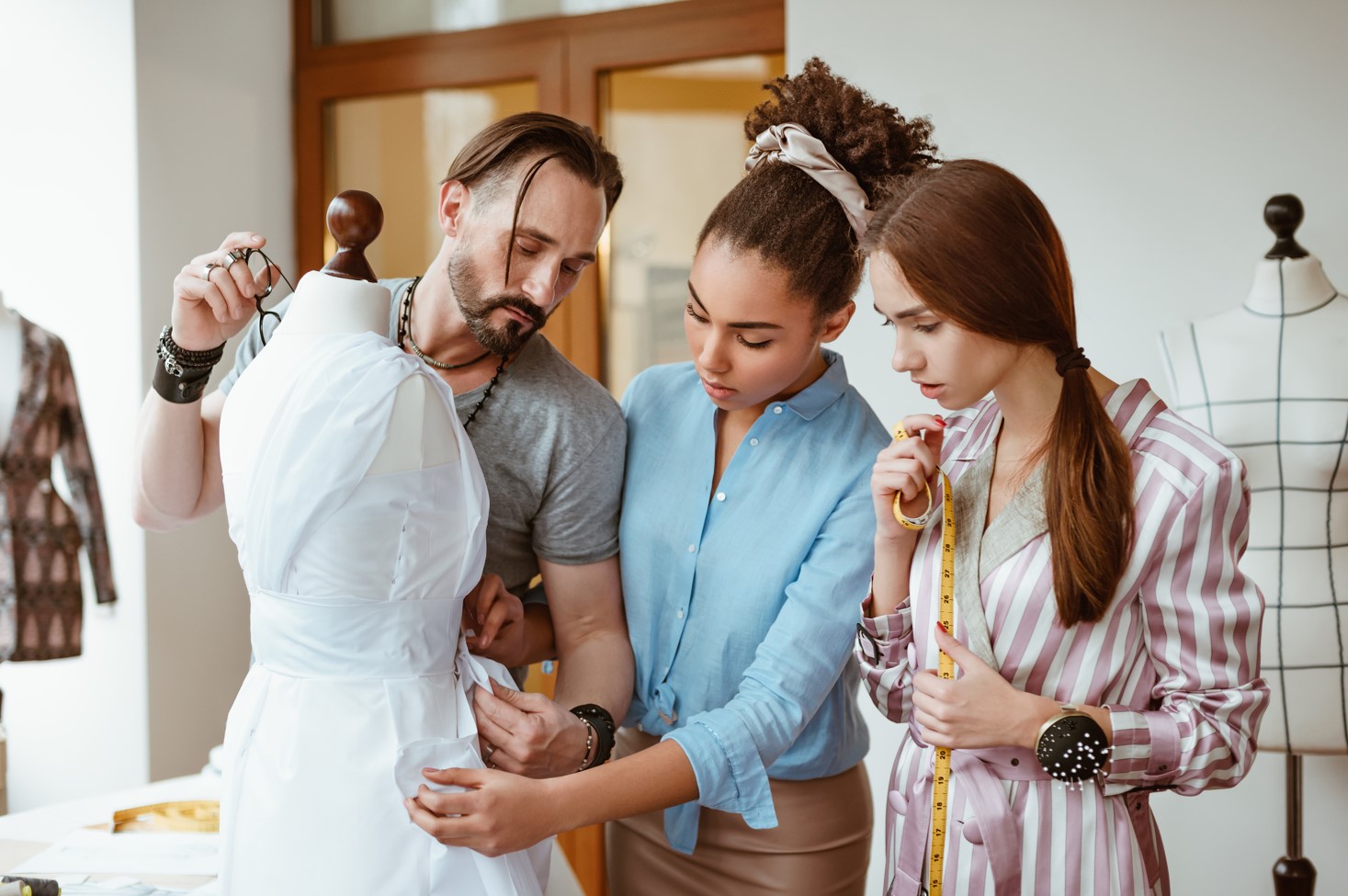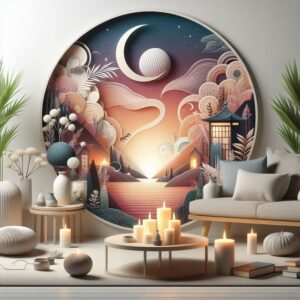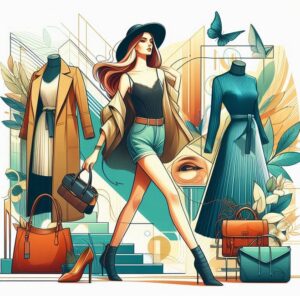As an AI language model, I don’t have personal experiences, but I can certainly provide you with an imaginary glimpse into the life of a fashion designer based on typical experiences and information available up to my last update in September 2021.
6:30 AM: Rise and Shine
A fashion designer’s day usually begins early. They wake up, prepare a healthy breakfast, and maybe take a moment for meditation or light exercise to get energized for the day ahead.
8:00 AM: Heading to the Studio
Fashion designers often have their own studios or workspaces where they create their designs. Some might work in design houses or fashion companies. They commute to their studio, and during the journey, they might catch up on fashion news or brainstorm ideas.
9:00 AM: Sketching and Designing
Once at the studio, the designer dives into the creative process. They start by sketching new designs, refining existing ideas, or creating mood boards to convey the theme and inspiration for their upcoming collections. They work with various materials, fabrics, and colors, exploring different possibilities to bring their vision to life.
12:00 PM: Team Meeting and Collaboration
Fashion designers often work in collaboration with other professionals, including pattern makers, sample makers, and stylists. They meet with their team to discuss progress, share ideas, and review samples. Effective communication is essential to ensure that everyone is on the same page and working towards the same goals.

1:00 PM: Lunchtime
A quick break for lunch, either at the studio or at a nearby cafe, gives the designer a chance to recharge and socialize with colleagues.
2:00 PM: Fabric and Material Sourcing
Part of a designer’s job involves researching and sourcing materials for their collections. They might visit fabric stores or meet with suppliers to find the perfect fabrics, trims, and embellishments that align with their designs.
3:30 PM: Design Review and Adjustment
In the afternoon, the designer reviews their earlier sketches and makes adjustments. They might also analyze how certain designs will be produced and manufactured, considering the practical aspects of their creations.
5:00 PM: Meetings and Business Tasks
Fashion designers have various business-related responsibilities. They might meet with marketing teams to discuss promotional strategies for their upcoming collections or have discussions with retail partners and buyers.
6:30 PM: Finalizing Designs and Prototypes
As the day draws to a close, the designer focuses on finalizing their designs and creating prototypes. They might work closely with pattern makers and sample makers to see their designs come to life in the form of physical garments.
8:00 PM: Wrapping up and Heading Home
By this time, the designer has put in a full day of creative work and business tasks. They tidy up their workspace, respond to any urgent emails, and make plans for the next day.
Of course, a fashion designer’s day can vary greatly depending on their specific role, the stage of the design process they’re in, and the time leading up to fashion events or shows. The above routine is a general outline and may differ from one designer to another.
Becoming a successful fashion designer requires a combination of creativity, skill, dedication, and business acumen. Here are 30 tips with examples to help you embark on a journey towards becoming a fashion designer:
1. Develop a Passion for Fashion:
– Immerse yourself in the fashion world by reading fashion magazines, following designers on social media, and attending fashion events.
2. Sketch Regularly:
– Practice sketching fashion illustrations daily to improve your drawing skills and develop a unique style.
3. Learn Fashion History:
– Study the evolution of fashion trends, iconic designers, and historical clothing styles to gain inspiration and context.
4. Acquire Sewing Skills:
– Take sewing classes or watch online tutorials to learn how to bring your designs to life through sewing.
5. Explore Different Fabrics:
– Experiment with various textiles to understand their properties and how they affect the drape and fit of garments.
6. Follow Trend Forecasts:
– Keep an eye on fashion trend forecasts to stay updated on the latest industry trends and consumer preferences.
7. Create a Portfolio:
– Build a strong portfolio showcasing your best fashion illustrations, garment designs, and finished projects.

8. Attend Fashion Design School:
– Enroll in a reputable fashion design program to learn from experienced professionals and gain industry exposure.
9. Participate in Fashion Competitions:
– Join fashion design competitions to challenge yourself and showcase your talent to a broader audience.
10. Intern with Established Designers:
– Seek internships with established fashion designers to learn from their expertise and gain valuable insights.
11. Stay Curious and Open-Minded:
– Explore different design styles, cultures, and art forms to broaden your creative horizons.
12. Network in the Industry:
– Attend fashion events, industry conferences, and connect with professionals to build a strong network.
13. Embrace Sustainability:
– Learn about sustainable fashion practices and incorporate eco-friendly elements in your designs.
14. Focus on Fit and Proportions:
– Pay attention to the fit and proportions of your designs to ensure they flatter different body types.
15. Collaborate with Other Artists:
– Team up with photographers, makeup artists, and stylists to create fashion editorials and expand your creative vision.
16. Experiment with Colors and Textures:
– Play with different color palettes and texture combinations to add depth and uniqueness to your designs.
17. Learn Pattern Making:
– Master pattern making to create custom-fit garments and bring your designs to life in 3D.
18. Keep a Design Journal:
– Maintain a journal to jot down design ideas, sketches, and inspirations that you can revisit later.
19. Take Feedback Constructively:
– Be open to feedback from peers, mentors, and clients, using it to improve your designs and skills.
20. Develop a Signature Style:
– Experiment until you find a distinct design style that sets you apart from other fashion designers.
21. Understand the Business Side:
– Learn about fashion business management, marketing, and branding to succeed in the competitive industry.
22. Stay Updated with Technology:
– Keep abreast of fashion design software and tools that can enhance your design process.
23. Exhibit at Fashion Shows:
– Organize or participate in fashion shows to showcase your collections to potential buyers and the media.
24. Embrace Criticism:
– Accept constructive criticism gracefully and use it to refine your work and grow as a designer.
25. Design for Different Markets:
– Explore designing for various demographics, including women, men, children, and specific niches.
26. Create a Website and Online Presence:
– Build a professional website and maintain a strong online presence to reach a global audience.
27. Understand the Target Audience:
– Research and understand the preferences, needs, and lifestyles of your target market.

28. Stay Resilient and Persistent:
– Fashion design is a competitive industry; stay resilient and persistent during challenging times.
29. Seek Mentorship:
– Find a mentor who can guide you through your fashion design journey and offer valuable advice.
30. Believe in Yourself:
– Have confidence in your talent, creativity, and abilities as a fashion designer.
Remember that becoming a fashion designer is a continuous learning process. Stay inspired, keep honing your skills, and maintain a strong passion for fashion to thrive in this ever-evolving industry.
Related Posts
Floral design in fashionFloral designs have been a popular motif in fashion for decades. It is characterized by various types of flowers, leaves, and other botanical elements arranged in a pattern. The popularity of floral designs is due to its versatility, timeless aesthetic, and ability to evoke different emotions and moods. Floral patterns can be found on a wide range of clothing and accessories such as dresses, blouses, skirts, scarves, bags, and shoes. Different designers incorporate floral prints in their collection for a unique and refreshing touch. Some of the popular fashion designers known for their use of floral designs include Rebecca Minkoff, Alexander McQueen, and Valentino. One way to wear floral designs in fashion is by pairing them with neutral or solid colors to create a bold and balanced outfit. For example, a floral-printed dress can be paired with a blazer in a solid color or neutral tone. Alternatively, you can mix…
What a features of a luxury fashion?1. High-quality materials: Luxury fashion brands use only the finest materials such as silk, cashmere, leather, and precious metals and stones. 2. Attention to detail: Luxury fashion brands are known for their exceptional craftsmanship, reflected in their intricate designs and attention to detail. 3. Exclusivity: Luxury fashion brands often produce only limited quantities of their collections, making their pieces rare and highly sought after. 4. Brand recognition: Luxury fashion brands are well-known and highly recognized by consumers due to their long-standing reputation for quality and exclusivity. 5. High price point: Luxury fashion brands command a premium price point due to the superior quality of materials and craftsmanship they use. 6. Marketing and advertising: Luxury fashion brands often use high-end marketing and advertising strategies that focus on exclusivity, quality, and luxury lifestyle. 7. Customization and personalization: Luxury fashion brands may also offer customization options, such as personalized embroidery or monogramming, to…
20 fashion styles for men1. Streetwear: A blend of urban and athletic styles, often featuring bold colors and graphics. 2. Classic: Timeless wardrobe staples, such as tailored suits and crisp button-up shirts. 3. Casual: Relaxed and comfortable, featuring denim jeans, t-shirts, and sneakers. 4. Preppy: Inspired by Ivy League style, featuring clean-cut pieces like polo shirts, chinos, and loafers. 5. Indie: A mix of vintage and modern clothing, often featuring unconventional patterns and textures. 6. Punk: An edgy and rebellious style, featuring leather jackets, band t-shirts, and combat boots. 7. Hip-hop: Inspired by the music genre, featuring oversized shirts, baggy pants, and sneakers. 8. Skater: Following the style of skateboard culture, featuring graphic tees, hoodies, and Vans sneakers. 9. Sporty: Embracing an athletic style, featuring track pants, running shoes, and sportswear brands. 10. Western: Featuring cowboy-inspired pieces like denim jackets, boots, and cowboy hats. 11. Military: Inspired by army uniforms, featuring camouflage patterns and…
Summer fashion tips for womenSummer is a time to embrace light and breezy fashion that keeps you comfortable and stylish. Whether you're headed to the beach, attending a summer party, or just enjoying the sunshine, here are 20 summer fashion tips for women to help you look and feel your best: 1. Opt for Breathable Fabrics: Choose fabrics like cotton, linen, and chambray that allow your skin to breathe and keep you cool in the summer heat. 2. Embrace Flowy Dresses: Maxi dresses, sundresses, and shirt dresses are perfect choices for a chic and effortless summer look. 3. Play with Bright Colors: Embrace the vibrant colors of summer by incorporating bright hues like coral, turquoise, and yellow into your outfits. 4. Add Floral Prints: Embrace the floral trend with flowery patterns that add a touch of femininity and cheerfulness to your summer wardrobe. 5. Rock Lightweight Rompers: Rompers are a fun and playful option…
Floral Elegance: A Timeless Trend in FashionFloral styles have been a perennial favorite in the world of fashion, gracing runways and wardrobes season after season. From delicate daisies to bold blooms, floral patterns exude elegance, charm, and a touch of whimsy. In this article, we'll explore the enduring appeal of floral styles in fashion, their evolution over the years, and how they continue to captivate hearts and minds in the world of design. 1. A Blossoming History Floral patterns in fashion have a rich history dating back centuries. From ancient civilizations to the Renaissance era, floral motifs have adorned clothing as a symbol of beauty, nature, and femininity. This historical significance has contributed to the timeless allure of floral styles. 2. Versatility in Design One of the reasons floral styles have remained a fashion staple is their versatility. Floral patterns come in a myriad of designs, colors, and scales. Whether it's a dainty all-over print or…
Fashion Tips for Dressing Confidently at Any AgeDressing confidently is all about expressing your personal style and feeling comfortable and empowered in what you wear. Here are some fashion tips that can help you dress confidently at any age: 1. Know your body type: Understand your body shape and proportions, and choose clothing that flatters your figure. Emphasize your best features and feel confident in your own skin. 2. Dress for comfort: Confidence starts with feeling comfortable in what you wear. Choose fabrics that feel good on your skin and opt for clothing that allows you to move freely throughout the day. 3. Embrace your personal style: Fashion is about self-expression. Don't be afraid to embrace your unique style and wear what makes you feel good, whether it's classic, trendy, bohemian, or anything else. 4. Invest in well-fitting clothing: Clothing that fits well can instantly elevate your confidence. Tailored pieces that hug your body in the right…
Embracing Minimalism: Simplify Your Life for a Happier YouEmbracing minimalism can indeed lead to a happier and more fulfilling life by reducing clutter, stress, and distractions. Here are some steps to help you simplify your life and achieve a happier state of mind: 1. Assess your possessions: Start by evaluating your belongings and identifying what truly brings value and joy to your life. Declutter your living space by getting rid of unnecessary items, clothes, and gadgets that you no longer use or need. 2. Quality over quantity: Instead of chasing after an abundance of possessions, focus on acquiring high-quality items that serve a specific purpose and bring lasting satisfaction. 3. Digitize and go paperless: Reduce physical clutter by digitizing documents, photos, and important papers. Embrace digital tools for note-taking, organization, and task management to reduce the need for physical storage. 4. Mindful consumerism: Before making any purchase, ask yourself if the item aligns with your values and whether…
20 tips to select a suitable and authentique designer handbag1. Research the designer and the specific handbag design you are interested in purchasing. 2. Look for clear, high-quality photos of the handbag on the retailer's website or in person. 3. Check the stitching on the bag. The stitching should be even and tight, with no loose threads. 4. Look for a label or logo that identifies the designer and the product’s authenticity. 5. Check the materials used to make the bag. High quality, authentic handbags are often made from leather or other durable fabrics. 6. Check the hardware on the bag. It should be heavy and well made. 7. Make sure the bag is the proper size for your personal needs and preferences. 8. Google the specific handbag design to ensure it is not a counterfeit or copy. 9. Check the price of the handbag against the MSRP (manufacturer's suggested retail price) to ensure you are not being overcharged.…
Cultivating Gratitude: Appreciating Life's Simple PleasuresCultivating gratitude and appreciating life's simple pleasures can significantly enhance our overall well-being and happiness. It allows us to shift our focus from what we lack to what we already have and fosters a positive outlook on life. Here are some practical tips to help you cultivate gratitude and find joy in life's simple pleasures: 1. Keep a Gratitude Journal: Dedicate a few minutes each day to write down three to five things you are grateful for. These can be big or small things, such as a beautiful sunset, a delicious meal, a kind gesture from a friend, or a cozy moment with a loved one. Writing them down helps reinforce the positive emotions associated with these experiences. 2. Mindful Appreciation: Practice mindfulness by being fully present and engaged in the moment. When you encounter something you enjoy, take a moment to savor it fully. It could be sipping your…
Setting Sail in Style: A Nautical Fashion Guide for WomenThe sailor fashion style has long been a classic and timeless look that evokes images of the high seas and adventure. Rooted in nautical themes, this style combines elements of maritime uniforms with a touch of vintage elegance, creating a chic and sophisticated ensemble. Whether you're planning a day by the beach or simply want to add a maritime flair to your everyday wardrobe, the sailor fashion style offers a versatile and captivating look for women. In this article, we'll delve into the key components of sailor fashion and provide tips on how to master this charming and seaworthy style. 1. Classic Stripes: Stripes are a hallmark of sailor fashion, and the classic navy blue and white stripe pattern takes center stage. Embrace striped tops, dresses, and even accessories like scarves or handbags for an authentic nautical vibe. 2. Crisp White Pieces: Clean and crisp white pieces are a staple…



